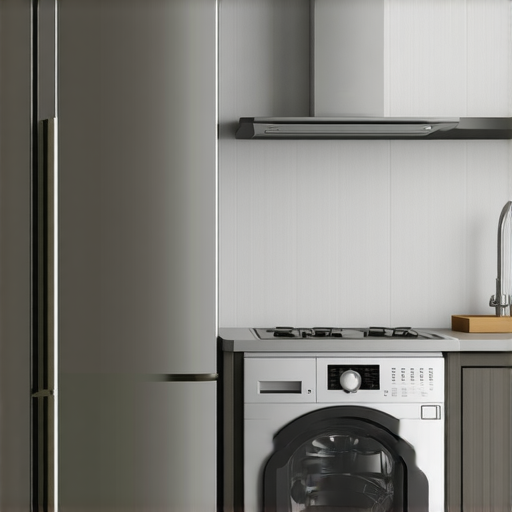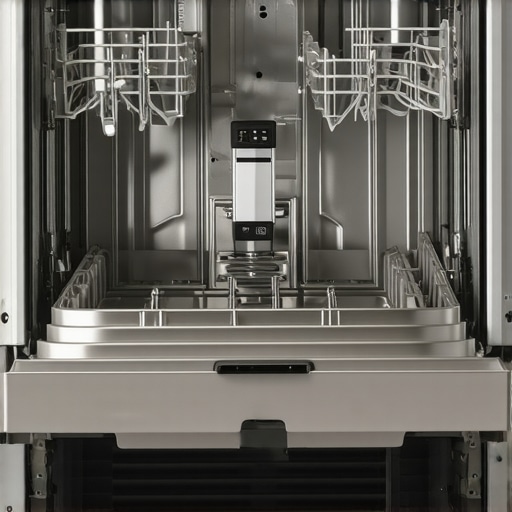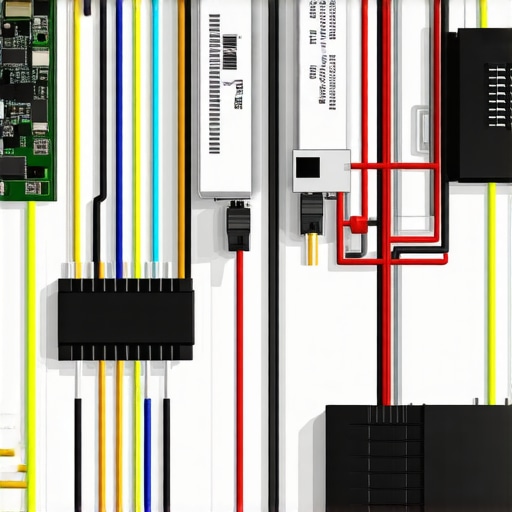My Unexpected Dishwasher Dilemma and the Spark of Inspiration
One busy Saturday, I noticed my dishwasher wasn’t cleaning dishes as efficiently as it used to. Frustration crept in, but I also saw it as an opportunity to learn more about troubleshooting and repairing my appliance. This experience ignited my curiosity about the intricacies of dishwasher diagnostics and parts, especially as I aimed for quick, reliable repairs in 2024.
Getting to Know My Dishwasher’s Heart: The Diagnostic Process
Initially, I thought it might be a simple clog or a worn-out part, but I soon realized that understanding the diagnostic process is crucial. I started by inspecting common issues like drainage problems, faulty sensors, and control panel errors. To my surprise, many of these problems could be diagnosed with just a basic understanding of dishwasher mechanics. I found that exploring detailed troubleshooting guides, like those on appliancebargainz.com, made the journey easier and more insightful.
How Do I Know Which Parts Are Essential for Quick Fixes?
Over time, I learned that certain parts are more prone to failure and are essential for fast repairs. Items like the door latch, spray arms, and water inlet valves often cause common issues. Having these on hand can turn a lengthy repair into a quick fix. I also discovered that using high-quality replacement parts, like those listed in best dishwasher parts guide 2025, can significantly improve repair efficiency and appliance lifespan.
What Are The Hidden Benefits of Mastering Diagnostics?
Mastering diagnostics not only saves time and money but also gives me a sense of empowerment. When I understand what’s wrong, I can make informed decisions about repairs or replacements. Plus, I avoid unnecessary expenses by choosing the right parts the first time. This knowledge also helps me troubleshoot other appliances, like ovens, which share similar diagnostic principles. For instance, I recently explored oven repair diagnostics and found many parallels that enriched my overall appliance maintenance skills.
Are There Common Pitfalls I Should Watch Out For?
Absolutely. One common mistake is jumping to conclusions without thorough inspection. Another is using low-quality parts that can lead to further damage. I also learned the importance of consulting authoritative sources, such as professional repair guides, to avoid costly missteps. For example, reliable diagnostic tips from troubleshooting tips proved invaluable during my repairs.
Curious About My Favorite Diagnostic Tools and Tips?
If you’re like me, eager to master your dishwasher repairs, I recommend exploring comprehensive guides and keeping essential parts ready. Sharing your experiences or asking questions can also help build a community of DIY enthusiasts. Feel free to comment below or browse more about oven repair tips and other appliance diagnostics.
Unveiling the Secrets of Efficient Dishwasher Troubleshooting
As an appliance repair enthusiast, I’ve discovered that understanding the diagnostic process is a game-changer. Identifying issues like drainage failures, sensor malfunctions, or control panel glitches can seem daunting initially, but with a structured approach, troubleshooting becomes manageable. Exploring detailed guides on dishwasher troubleshooting helps demystify common problems and accelerates repairs.
Which Parts Are Critical for Fast Fixes and How to Identify Them?
In my experience, certain components like the door latch, spray arms, and water inlet valves are frequent culprits behind malfunctioning dishwashers. Keeping these on hand allows for swift replacements, minimizing downtime. For high-quality parts that enhance repair success, I rely on guides such as best dishwasher parts 2025. Using reliable replacement parts not only speeds up repairs but also extends your appliance’s lifespan.
What Are the Hidden Advantages of Mastering Diagnostics?
Mastering diagnostic techniques empowers you to make informed repair decisions, saving both time and money. It also helps in selecting the right parts the first time, avoiding unnecessary expenses. This skill set is transferable to other appliances, such as ovens, which share similar troubleshooting principles. For instance, exploring oven repair diagnostics broadens your appliance maintenance expertise and boosts confidence in tackling various issues.
Are There Common Pitfalls That Can Trip Up Even Experienced DIYers?
Absolutely. One common mistake is rushing into repairs without thorough diagnostics, leading to misdiagnoses and wasted effort. Another is using subpar parts, which can cause further damage or recurring problems. Consulting authoritative sources, such as reliable troubleshooting tips, helps prevent these pitfalls. Proper inspection and patience are key to successful repairs.
What Diagnostic Tools and Tips Do Experts Swear By?
If you’re eager to elevate your repair skills, I recommend investing in a multimeter and familiarizing yourself with diagnostic guides. Keeping essential spare parts, like door latches and spray arms, ready for quick swaps, can drastically reduce repair times. Sharing your experiences or seeking advice from online communities adds another layer of insight. Curious about more advanced diagnostics? Check out oven repair diagnostics and learn how to adapt those skills for dishwashers. Remember, the key to expert repairs lies in continuous learning and practical application.
Deepening My Diagnostic Journey: Navigating Complexities and Nuances
As I delved further into troubleshooting my dishwasher, I realized that many issues are layered and sometimes intertwined. For instance, a drainage problem might stem from a clogged filter, a faulty drain pump, or even wiring issues. Recognizing these interconnected possibilities requires a more nuanced approach than just following a troubleshooting guide step-by-step. It’s about developing a diagnostic intuition—learning to read the subtle signs and symptoms that point to specific causes. Over time, I began to notice patterns, such as how certain error codes correlate with particular component failures, which significantly sped up my repairs.
The Art of Prioritization: Which Fixes Come First?
One challenge I faced was deciding which component to tackle first. Should I replace the water inlet valve or inspect the control board? I learned that prioritizing based on symptom severity and likelihood is crucial. For example, if your dishwasher isn’t filling at all, focusing on the water inlet valve and float switch makes sense before delving into the control panel. To refine this skill, I often consult detailed diagnostic flowcharts found in authoritative guides like comprehensive troubleshooting resources. These help me develop a logical sequence, minimizing unnecessary disassembly and guesswork.
How Do I Balance Cost, Time, and Reliability in Repairs?
One of the most sophisticated considerations in diagnostics is evaluating whether to repair or replace. This decision hinges on assessing the cost of parts and labor against the age and overall condition of the appliance. I’ve found that investing in high-quality replacement parts, like those featured in top repair parts guide 2025, often pays off in durability and fewer return visits. Moreover, understanding the diagnostics helps me avoid chasing phantom problems, saving both time and money. This strategic approach transforms troubleshooting from a mere repair task into a smart investment in appliance longevity.
What Are the Hidden Challenges in Advanced Diagnostics?
Beyond basic troubleshooting, advanced diagnostics involve understanding electrical schematics, sensor behaviors, and software error codes. This is where experience and continuous learning come into play. For example, I recently explored oven repair diagnostics to expand my skills, discovering parallels that apply across appliances. One hidden challenge is misinterpreting diagnostic codes—without proper tools or understanding, it’s easy to misdiagnose. I’ve invested in a good multimeter and diagnostic tools, which have become invaluable. Sharing insights with online repair communities helps me stay updated on new troubleshooting techniques and avoid common pitfalls, like overlooking wiring faults or misreading error code sequences.
Reflections: How Diagnostics Shape My Repair Philosophy
Mastering diagnostics has profoundly shifted my repair philosophy from reactive to proactive. Instead of just fixing what’s broken, I now aim to understand why it failed and how to prevent recurrence. This mindset encourages meticulous inspection, patience, and continuous education. I find that each successful repair boosts my confidence, empowering me to tackle more complex issues. If you’re eager to elevate your skills, I invite you to explore detailed guides on effective troubleshooting and diagnostics. Sharing your experiences or questions can foster a community of DIY enthusiasts committed to smarter repairs and longer-lasting appliances. Remember, every diagnostic challenge is an opportunity to learn and grow, turning everyday repairs into rewarding personal milestones.
Deciphering the Intricacies: How Deep Diagnostic Knowledge Transforms Repairs
As I progressed in my repair journey, I realized that many dishwasher issues are complex mosaics of interconnected problems rather than isolated faults. For instance, a persistent leak might stem from a compromised door seal, but could also be due to misaligned spray arms or even electrical anomalies affecting the float switch. Developing an intuitive diagnostic approach requires understanding electrical schematics and sensor behaviors, which can seem daunting at first. I found that consulting detailed wiring diagrams and advanced troubleshooting guides, such as those available in comprehensive troubleshooting resources, significantly enhanced my diagnostic acuity.
What Are the Nuances in Electrical and Software Diagnostics?
Modern dishwashers increasingly incorporate electronic control boards and software diagnostics, adding layers of complexity. Recognizing error codes that indicate specific sensor failures or communication issues is crucial. For example, a code signaling a faulty thermistor may also be symptomatic of wiring faults or a malfunctioning control board. Advanced diagnostic tools, like multimeters and specialized software interfaces, have become indispensable. They allow me to verify sensor resistance, inspect circuit continuity, and interpret software signals accurately. Staying updated with the latest repair techniques through authoritative sources, such as oven and dishwasher diagnostic guides, ensures I’m prepared for these technological challenges.
Incorporating visual aids like wiring schematics or diagnostic flowcharts can drastically reduce troubleshooting time. These visuals help decode complex error patterns and streamline decision-making, especially when dealing with intertwined electrical issues.
How Can I Cultivate a Proactive Repair Philosophy?
Mastering diagnostics isn’t just about fixing the immediate problem; it’s about adopting a proactive mindset that minimizes future failures. I now focus on preventive maintenance—regularly inspecting seals, filters, and sensors, and replacing aging parts before they cause breakdowns. This approach necessitates a deep understanding of component lifespans and failure modes, which I continuously expand by studying authoritative guides and engaging with online repair communities. Sharing experiences and troubleshooting tips in forums fosters collective growth and keeps me abreast of emerging issues and solutions.
What Are the Ethical and Practical Considerations in Advanced Diagnostics?
With greater diagnostic power comes responsibility. Ensuring accurate assessments prevents unnecessary part replacements and reduces waste, aligning with environmentally sustainable practices. Moreover, transparency with clients about repair limitations and costs fosters trust. For DIY enthusiasts, adhering to safety protocols—such as disconnecting power before inspecting wiring or control boards—is paramount. Leveraging authoritative resources like reliable troubleshooting tips helps maintain ethical standards and technical accuracy.
Join the Conversation: Elevate Your Repair Expertise
If you’re eager to deepen your diagnostic skills and tackle complex dishwasher problems with confidence, I encourage you to explore these advanced strategies and share your experiences. The journey towards mastery is ongoing, and engaging with a community of like-minded DIYers and professionals can provide invaluable insights. Dive into detailed guides, experiment with diagnostic tools, and remember—every challenge is an opportunity to learn and refine your craft. For continued growth, check out oven repair diagnostics and expand your troubleshooting arsenal today.
Things I Wish I Knew Earlier (or You Might Find Surprising)
The Power of Patience in Troubleshooting
One lesson I learned the hard way was that rushing into repairs often leads to misdiagnosis. Taking the time to thoroughly inspect and understand the problem can save hours and money. I once replaced a spray arm prematurely, only to find out the real issue was a clogged filter. Patience truly pays off in dishwasher diagnostics.
Understanding Error Codes Can Save You Time
At first, I ignored error codes, thinking they were just suggestions. Now I realize they are invaluable clues. For example, a drain error code pointed me directly to the drain pump, making repairs smoother. Learning to interpret these codes has made my troubleshooting much more efficient.
Quality Parts Make All the Difference
Using cheap, low-quality replacement parts might seem like a saving, but it often results in more breakdowns. Investing in reliable parts, like those recommended in best dishwasher parts 2025, ensures longevity and smoother repairs.
Visual Aids Are Game Changers
Having wiring diagrams and diagnostic flowcharts at hand transforms complex problems into manageable steps. Visual tools help me understand interconnected issues, such as wiring faults that cause sensor errors, and prevent unnecessary disassembly.
The Importance of Preventive Maintenance
Regular inspections and timely part replacements prevent major breakdowns. I now check seals, filters, and spray arms periodically, which keeps my dishwasher running reliably and reduces emergency repairs.
Mastering Diagnostics Boosts Confidence
Every successful repair increases my confidence and deepens my understanding of appliance mechanics. This proactive approach turns troubleshooting from a chore into a rewarding challenge, inspiring me to learn more about other appliances like ovens, with resources such as oven repair diagnostics.
Resources I’ve Come to Trust Over Time
- appliancebargainz.com: This site offers comprehensive troubleshooting guides, diagnostic tips, and quality parts recommendations. It’s my go-to resource for appliance repairs.
- PartSelect: Their detailed parts diagrams and repair tutorials help me understand component functions better, making repairs more predictable.
- YouTube Repair Channels: Visual demonstrations from experienced repair techs have been invaluable for complex diagnosis and repair techniques.
- Manufacturer Manuals: Official manuals provide exact specifications and troubleshooting steps, ensuring I don’t miss critical details.
Parting Thoughts from My Perspective
Mastering dishwasher diagnostics in 2024 has been a game-changer. It’s about more than fixing appliances; it’s about understanding them deeply, which saves time, money, and frustration. I encourage anyone interested in DIY repairs to embrace patience, invest in quality tools and parts, and utilize trusted resources like diagnostic guides. Remember, every challenge is an opportunity to learn and improve. If this resonates with you, I’d love to hear your experiences or tips—share in the comments or reach out. Happy troubleshooting!”},


